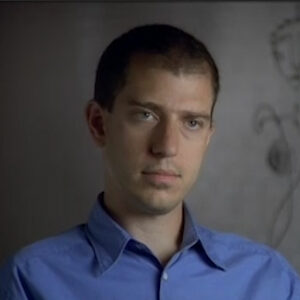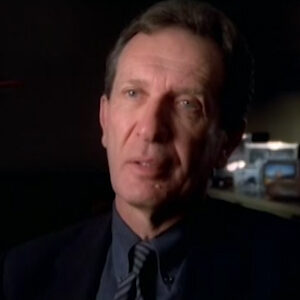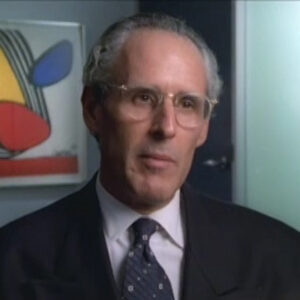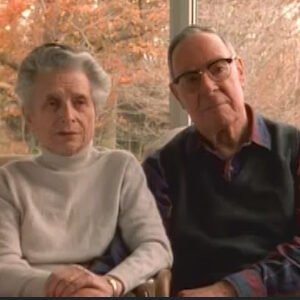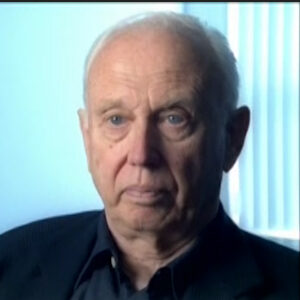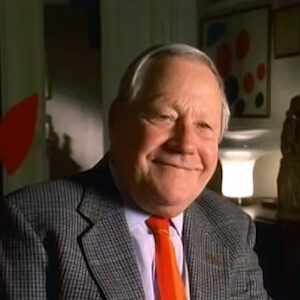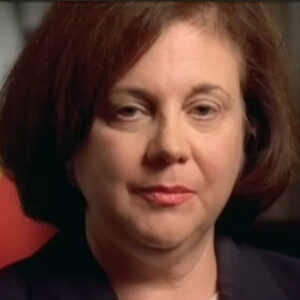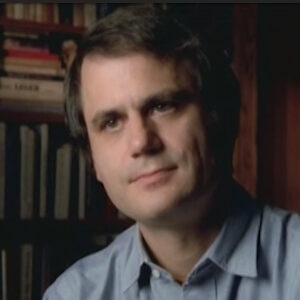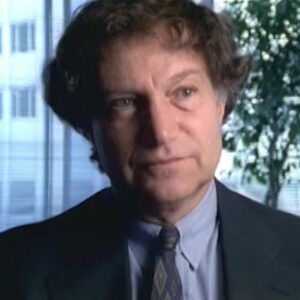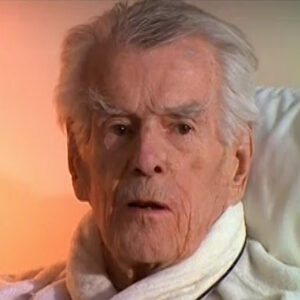Pedro Guerrero: It was very it was very slow coming because I was very involved doing other things. But I think it was at the museum modern art that I saw for the first time, something that caught my eye. And that was the I think was called a fish trap or some kind of trap. Anyway, it was a wonderful thing. And I thought, what a wonderful conception. Then I realized that there was a man behind it. Alexander Calder. And more and more, I began to be fascinated by it, but not necessarily becoming obsessed with it. You know, I just fascinated. And as a architectural photographer. And then eventually photographing interiors for house and garden. Occasionally I would come upon a house that had a Calder in it. And that was always very exciting to me to to recognize the work as being Calders. Then then, of course, what what really happened, again, is working with Frank with. Well, actually, Frank Lloyd Wright. Well, that’s much later we’ll talk about that. I. I first was lucky enough to be assigned to do the Calder a kitchen through house and garden. And they had. I’m sorry, I’m doing a lot. I’m trying not to. They had they had concocted a story called A Man’s Influence in the Kitchen. To appear in some July issue, which they knew probably would only be seen for about 30 seconds by only half of the subscribers. So it was sort of a throw away issue and sort of a throwaway title, too, because I knew enough about Sandy Calder to know that Sandy was not going to demonstrate, you know, how to toss a salad or how to flip a flapjack or something. But I had an idea that the kitchen was going to be they influence was going to be his own artwork. And and I was right now the the the editor that I was sent there with was very skeptical about what we were going to find. She had no idea.
Interviewer: Jump Ahead, tell me what you found when you walked into his kitchen.
Speaker Oh, OK. In the first place in the Calder residence was something that we had never run into before. It was a black farm. It was a New England farmhouse painted black. That obviously was not maintained except just throwing stuff out of the way, you might say, walked into the place. And as we got there, just as Sandy was having his lunch and it was like walking out of the dark, into the bright sunshine to to see the atmosphere that that they had created. It was absolutely exciting to me. And I knew that I was going to like this place and the people. Sandy. Alexander Calder, because by that, I didn’t know that he was called Sandy. But when I was introduced to him, he said, call me Sandy. From the very beginning. But beyond Sandy, there was this wonderful atmosphere that he had created. There were. Oh, I know. Early American. Hey, cradle hanging on the wall. It was full of of Les James and and Miro’s on the wall. And noisemakers that Sandy had concocted by tin cans and handles. And there wasn’t anything in that that that spelled house and garden to me or to the editor because we had so used to having that. So anyway, I know instinctively that the editor was going to turn this job down. So while she politely talked to Louisa Calder, I went into the kitchen, which was what we were assigned to do. And I, with an eight by 10 camera, took candidly two or three photographs of that fantastic kitchen.
Interviewer: What was your impression? What was there? Give me a list.
Pedro Guerrero: Oh, Let’s just take the stoves as an example. Because all the house and garden illustrations almost have to have advertising, all things in them. Here were three stoves that were used in this kitchen. There wasn’t anything in there that had been bought within the last 30 years. There was a wood stove on top of which was a gas burner. They obviously hadn’t used the wood stove for a long time and weren’t about to end. And on the far end was an old white porcelain electric stove. And those were the only three things that Sandy had not created. Otherwise he had. He had the table, or at least he’d bought the table from the countryside. Somehow he had made the cupboard. The linoleum on the floor had been eaten away and somehow or other didn’t really matter because. It looked as if it had been designed that way. Walking in. When I first went there, Louisa had made a big bowl of quince butter. And it was sitting on on one of those marvelous trays that Sandy made out of flattening out a olive oil, a gallon cannibal olive oil and then putting it on a wooden frame. And that was. That was Sarah Phrae. And then all the marvelous ladles and stuff that and bread that Louisa I had made. I mean, this whole thing was an experience that I had never had before, certainly never something that we would be expecting with house and garden. Off to the side and out the windows with a grove, with the quince trees that Louisa had picked the quince from in. And on top of that was that gorgeous. After the initial introduction and actually, I spent very little time with with Sandy on that day. It was mostly with Louisa. But after I got back, I realized that no one had made that had worked on a book on Calder since 1943 or something. It’s was 62. So I decided that maybe I should start collecting material on the Calders. And I wrote a letter asking him, could I come back and elaborate with the idea of doing a book? And they said, come ahead any time. So that started a series of visits and it all they had to do is be on the premises. I mean, they they I could come any time as long as they were there and saw that for the next 12 or 13 years. I kept going back to France or they would be here or when I started working on my book, then I started travelling to Denmark, to Italy, to Brussels, Belgium. And it got to the point that that Sandy also decided to depend on me whenever he needed a photograph. He would write me a note and say there is a a big stabile in Waterbury if, you know, if you’re going by that way. Which, of course, I wasn’t always but, you know, I did it anyway. And also when he started doing his book, he’d call me in and say, I want you to take a picture of this, but you can’t have it is for me. So we we had a very nice, amicable relationship. It was Sandy was old enough to have been my father in a way. And but we I respected him as I did my own father. And I think somehow or other, he appreciated the the relaxed relationship that he and I both had.
Interviewer: What was he like to work for, as it were? Was he did he direct you? Was he demanding that you look at your photographs and say, you know, I want this way, you’re not getting it. You’re what was his?
Pedro Guerrero: It is as far as as Sandy making any demands or being difficult to work with. He wasn’t because you didn’t get the feeling that you were working for him. You’re working with him. I didn’t I didn’t have to show him what I did after I showed him my first shootings. He knew that whatever I was going to do, I was going to do it with care and with study. And he and I discussed that beforehand. It’s particularly hard when you’re going to shoot a mobile, which is moving all the time. You almost have to know instinctively when you want to stop that. Otherwise, elements begin to run into each other. And and he knew that. I understood that. And I don’t know whether I understood that instinctively or whether I made the mistake once or twice. And he corrected me. But it was always a jolly relationship. I enjoyed his company and I have a feeling he enjoyed mine.
Interviewer: Were you ever present when he was working? What was he like? I’m thinking now, this is a question of one artist observing another artists.
Pedro Guerrero: As far as some as being present when he was working. I was able to be with him often enough so that he got very used to having me around and be and was not conscious of my taking photographs, which is what I wanted anyway. He never seemed to be an awkward situation to have me there. I never interrupted anything he was doing. I never got in the way of it.
Interviewer: I’m really asking about what is your perception of him as an artist? How did he work? What did he? He was so passionate chat while he was working? Did he? You know, was he a maniac?
Pedro Guerrero: What was the the the amount of energy and force he put into his work? Was was all consuming for him. I think that he was so passionate about what he was doing and so lost in what he was doing that I could have been five or six other guys and he wouldn’t have paid any attention anyway. He was completely in Gaul and enveloped in what he was doing. And usually he worked in such unorthodox way. You know, he wasn’t really the kind of guy that was with a palette and with a beret. He wasn’t doing a great tome’s. He was discovering things as he was painting, for example. And when he was balancing a mobile also, he seemed to completely concentrate on on what he was doing. And I could circle him and shooting. And it never bothered him once. I think I think one of the things and I think Jean Lippman said this, that any way that I seem to be able to lose myself as far as as the artist that I was photographing was concerned that I wasn’t there. But obviously, the photo that resulted indicated that I had been Sandy was not at all it was not an awkward situation with him at all. What? Once or twice he’d say, if you want to see me paint, you’re gonna have to come with me a couple of times.
Interviewer: Let’s cut for a second because. Was there anything surprising about how he worked?
Pedro Guerrero: Yes, particularly when he was doing his quashes. He did not work with an easel. He would be working on a table with with the material flat on. Usually, you know what’s on paper. He’d put blobs of, say, black ink, great big blobs on one side, and then he’d lift the paper and let let these blobs run down. Then he would do another color in the other direction. And so he would get a crosshatching of of long lines. And then he would fill those in with circles or with triangles. And and that was something he couldn’t have conceived beforehand. I still call that part of his found objects, Art, because he didn’t really know how these things were going to go. He he couldn’t direct them exactly the way he wanted them. But that surprised me. And I think I have one or two of those pieces that that he did that way. And I’m crazy about them, but I don’t think that he could sketch them. He this is something he did as he went along. As far as the as the other the bigger work like the stablies and the mobiles, I think he had maybe some preconceived notion of what he was going to do. But I don’t think, again, he could sketch them. They were all in his mind and and they took whatever shape they dictated for him or that, you know, he found a solution for completely unorthodox. I never saw him doing, for example, some of the early some of the stuff that he had done earlier, where he did pictures of firemen or or drawings, say of of of Ben Hur circling an arena. That was something I never signed, do I? I came into the picture with him when he was doing all these kinds of crazy things with with his quashes.
Interviewer: Describe whether Calder ever talked with you about art or whether you tried to talk with him about art and what the result was.
Pedro Guerrero: I don’t think there’s any place there. Yeah. We didn’t we didn’t talk about profound things.
Interviewer: Can you imitate the way he talked?
Pedro Guerrero: Well. Well, I’ll tell you, I can’t imitate it. Because when I first heard Sandy speaking, I thought he was speaking to me in French. What happened was I think he’d had he had a speech impediment. And I found out since that he probably had a stroke at one point and that affected the speech. Thank God for Louisa because Louisa was his translator. More often than than than not, when we are having a conversation, Louisa would say. Sandy just said this. He it was very guttural. I mean, it was a very heavy tongued speech, but it was very profound. I mean, he could be cutting when he wanted to get across to you. He would be able to do it. Perfectly enunciated every every one of those words completely. But in ordinary conversation, when he was just talking it quite often, his tongue got heavy and you lost him. And only Louisa seemed to know exactly what he was saying. It very, very hard to imitate.
Interviewer: So it wasn’t much of a talker?
Speaker No, I’d say he was. He was a great talker and very profound sometimes. But you had to. I think he was better when there was more than just one person involved, because Sandy was loquacious fellow and he was always the life of the party and he loved it. And if he is, he wasn’t always taking over the the the the whole party. But he always had something pithy to say and to the great amusement of everybody, including himself.
Interviewer: What’s this idea that I’ve heard that he was he was so nice. He was so wonderful. He was a friend for life. But don’t cross him.
Pedro Guerrero: And. The idea that that Sandy was the marvelous clown, the the great friend who wasn’t never lost his temper is really not true. Too many people have learned the hard way that Sandy could be very cruel. And I think he was there, there’s one wonderful story about having been the the the guest of honor and a woman, a prominent woman, the wife of a very prominent man, was put beside her. And besides Sandy, that is. And throughout the evening, I guess Sandy didn’t have anything to say to her. She talked to him and he didn’t say anything to her at all. And then, as happened often with Sandy, he went to sleep. He put his hands in front of it and put his head down, went to sleep. And the woman said, what’s so great about sitting next to this guy? You know, everybody said he was fascinating. He’s fast asleep. And he raised his head up and he said, I wouldn’t have gone to sleep if you had been such a bore. And that was the kind of humor I mean, not that was his cruel humor. And I think she’d earned it. But on the other hand, it’s sort of the first time I saw the Calders in France after I had arranged to continue to photograph for them. I arrived at the tour station dressed in my gray flannel suit, my wingtip shoes, and I had bought a special velour hat with a feather on the side. And suddenly there was Sandy coming at me and I thought he was going to embrace me. And I walked right up to him. He took my hat and slung it as far as he could. I never even bothered to see where it landed. I realized that from that day on, my life with him would change, even including the way I was going to dress for the rest of my time. And it also established a relationship between us. I knew that that he was making a statement and didn’t even have to open his mouth. That from then on, I knew exactly how Sandy felt about me and what I had been. And as I said, he changed me. From then on the way, I viewed myself and everything around me and the entire world. He was that much of an influence to me. And having come from the strict demands of Frank Lloyd Wright, everything had to be just so and everything. Sandy did not care. Sandy was completely unconventional the way he dressed. In fact, I must say that he influenced my own son so much that I couldn’t get my son out of a red shirt and a pair of khaki pants when he was only about seven or eight years old.
Pedro Guerrero: Could you just mention that you worked for Frank Lloyd Wright for photographing for 20 years? So we can cut that in.
Pedro Guerrero: OK. Yes. Prior to working with with Sandy Calder, I had worked with Frank Lloyd Wright for about 20 years.
Interviewer: Great. So that sounds like a pretty transcendental moment. Can you describe briefly how it actually did change your life?
Pedro Guerrero: Well. And, you know, it’s it’s too complicated because, you know, in a way, this this duplicate is something that my dad had done to me one time. I had been painting signs from my dad. And on a hot summer day, I was I was painting a sign on a on a tin roof in Arizona. And the sun was so hot. I went downstairs and bought myself a farmer’s hat to ward off the sun. And my dad came through inspecting the job and he climbed up the ladder on to her. I was painting a sign, grabbed my hat and threw it as far as he could. And he said, You’re fired. Go home. I was 20 miles from home and. I had to hitchhike home. That was an experience that I had with dad, which was one of anger on his part, but the one I had with Sandy was one of one I don’t know. Is a prank all done in good humor.Cost me a hell of a lot more. But but but it was worth it.
Interviewer: Professionally, how did Sandy change your life?
Pedro Guerrero: Well, when when I started doing the book, that became a book that was Sandy started doing his book and they paralleled each other for a long time, and he’d call up and say, How’s your book coming? And the only reason he asked me is not because he really wanted to know. He won’t know how much more time he had to work on his. I gave up doing the kind of work that I’d been doing before for house and garden with decorators. And I began to concentrate more on doing the work of artists. I decided that I was going to work with with artists. And of course, after after Sandy died, I started doing Louise Nevelson and I worked with her for a while.
Interviewer: Did he changed the way you looked through your camera?
Pedro Guerrero: Ah, if he did, I wasn’t aware of it. If if Sandy changed the way I looked to my camera, I was not aware of it at the time. I tried to I tried to do the same thing with Sandy that I did with Mr. Wright, and that is that I was I substituted myself for their eye. Their vision of what they were doing and. In that way, I became sort of unimportant, except as a as as a guy that wielded the camera.
Interviewer: After he passed away what did you lose?
Speaker Oh, God, it was you know, it was a it was. It was a great blow. It coming, coming just five, five years after I’d lost my original mentor, Frank Lloyd Wright. And then and then Sandy. Well, no, actually, Sandy died many years later, but he came in about three years after Wright had died. I felt a great void. I knew, for example, that I wasn’t going to be trailing after him anymore. I wasn’t going to take a plane with with the Whitney Museum so that I could photograph Sandy painting the pods on on on on a jet, for example, which which I did in 75 and or having Sandy send me a card saying, I want you to go someplace. And if you’re there or if you’re going someplace, there’s a thing I want you to do. And in Holland or in some place in Italy. It was a big void. It’s hard to describe because it happens. I mean, you find out that they. I saw him two days before he died. And the only thing that happened there is that I began to be a little wary about who I was going to tackle next in the way of an artist, because Frank Lloyd Wright died within two months after I shot him for the last time or photographed him for the last time. And then Sandy died two days after I had photographed him for the last time and I was beginning to think that I was coming to these people too late or that one more of those incidences and people would start fearing me. They say, oh, my God, it comes Guerrero. How long could I have?
Interviewer: What? What do you think? The world, what should the world? What should people know about Alexander Calder?
Pedro Guerrero: Oh, I think the world should know about him, I think most children should know about Alexander Calder cause Sandy was never went beyond being a child with the stuff he’d he made. He was interested in so many things. He could make a piece of art out of anything he touched. If it was a Bible that he created a horse out of or a tin can, that he made a soldier out of those. Those are things that I think should fire everybody’s anybody’s imagination. But it also brought people and is still doing it. And more and more, I think is going to happen. People are going to become more aware of the fact that not that you don’t have to be a Leonardo da Vinci or even a Picasso, that a man like Calder can can be as exciting as any of those people can because of the things he’s been able to create or the things that come out of his head. And you don’t know how it happened that. What it was doing there or and there’s been no one that I know of that has come anywhere near having his kind of vision and inventiveness, and I’m not sure that the next person that comes around is going to be anywhere near what he did. Going to be something entirely different. His place in society, he holds by himself, nobody can say Calder nd so and so and so on. So we’re cut out of the same cloth they did. You can’t tell who did this and who did the other. Sandy stands alone in what he has been able to accomplish and what he’s been able to leave for the world.
Interviewer: Thank you. Let’s cut.


